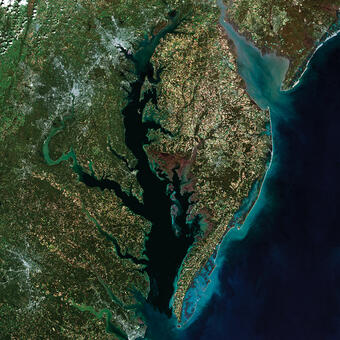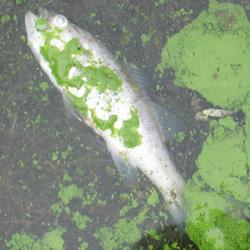Review of Wildlife Health Outcomes and Potentially Toxic Algal Blooms in the Chesapeake Bay
Scientists provide resources that review algal toxin data, explore links between avian mortality and toxin exposure, and identify future research needs to predict algal toxin health hazards and risks for birds and other wildlife in the Chesapeake Bay.

Chesapeake Bay—the largest estuary in North America—provides critical wildlife habitat and diverse recreational opportunities. The Chesapeake Bay has been historically affected by human activities (for example, agriculture, development, energy production, industry, mining, and transportation) that have resulted in point and non-point source releases of nutrients, pesticides, metals, and industrial, personal care and household use chemicals in the watershed. Some of these activities can alter biological and environmental processes, likely contribute to changes in the frequency of algal blooms, and can be harmful to wildlife, companion animals and humans and recreational use of the estuary. Our understanding of the factors that trigger release of algal toxins is limited. These information gaps prevent a comprehensive understanding of algal toxin exposure pathways, and consequences and risks of these harmful algal blooms (HABs) to birds and other wildlife using these aquatic habitats.
To fill those gaps, researchers reviewed government reports, databases and scientific literature, and compiled wildlife mortality events and algal toxin and bloom occurrences for the Chesapeake Bay between 2000 and 2020. These data were used to summarize adverse health outcomes for waterbirds and other wildlife that were associated with potentially toxic algae and algal bloom events in the Chesapeake Bay.
Review findings indicate that microcystins were the dominant algal toxins found in the Chesapeake Bay drainage with concentrations in water approaching or exceeding human-based thresholds for ceasing recreational use and drinking water at several locations. In agreement with a similar review for Federal Lands across the Nation, there were few waterbirds or other wildlife mortality incidents that could be definitively linked to HABs, and in most instances the relation was by association, indirect or coincidental.

Based on the review, several research needs were identified to increase our understanding of the consequences of algal toxin exposure to wildlife in the Chesapeake Bay, and elsewhere. For example, additional information on toxin exposure routes, comparative sensitivity among species, consequences of sub-lethal exposure, and the development of better diagnostic criteria for toxin exposure are essential to reliably diagnose algal toxin effects. Meeting these needs is essential for resource managers to identify and evaluate mitigation measures, if needed, to reduce wildlife exposure.
This research was funded by Ecosystems Mission Area’s Environmental Health Program’s Algal Toxins and Harmful Algal Blooms Integrated Science Team to provide and understanding of the causes, controls, and health outcomes associated with algal toxin exposure using a one-health approach that recognizes that that humans and wildlife can be influenced by health challenges in their shared ecosystem.
Algal and Environmental Toxins Research Laboratory — Lawrence, Kansas
Toxins and Harmful Algal Blooms Science Team
Mixtures of Algal Toxins Present Prior to and After Formation of Visible Algal Blooms—Science to Inform the Timing of Algal Toxin Exposure
Are Naturally Occurring Algal Toxins in Water Resources a Health Hazard?
Evaluating Linkages Between Algal Toxins and Human Health
U.S. Geological Survey Scientists Complete First Systematic Regional Survey of Algal Toxins in Streams of the Southeastern United States
Algal Blooms Consistently Produce Complex Mixtures of Cyanotoxins and Co-Occur with Taste-and-Odor Causing Compounds in 23 Midwestern Lakes
Wildlife mortality events in counties surrounding the Chesapeake Bay recorded in the Wildlife Health Information Sharing Partnership Event Reporting System (WHISPers) from 2000-2020 Wildlife mortality events in counties surrounding the Chesapeake Bay recorded in the Wildlife Health Information Sharing Partnership Event Reporting System (WHISPers) from 2000-2020
Great Blue Heron collection at Poplar Island Complex and Chesapeake Marshlands National Wildlife Refuge Complex Great Blue Heron collection at Poplar Island Complex and Chesapeake Marshlands National Wildlife Refuge Complex
Review of harmful algal blooms effects on birds with implications for avian wildlife in the Chesapeake Bay region Review of harmful algal blooms effects on birds with implications for avian wildlife in the Chesapeake Bay region
Scientists provide resources that review algal toxin data, explore links between avian mortality and toxin exposure, and identify future research needs to predict algal toxin health hazards and risks for birds and other wildlife in the Chesapeake Bay.

Chesapeake Bay—the largest estuary in North America—provides critical wildlife habitat and diverse recreational opportunities. The Chesapeake Bay has been historically affected by human activities (for example, agriculture, development, energy production, industry, mining, and transportation) that have resulted in point and non-point source releases of nutrients, pesticides, metals, and industrial, personal care and household use chemicals in the watershed. Some of these activities can alter biological and environmental processes, likely contribute to changes in the frequency of algal blooms, and can be harmful to wildlife, companion animals and humans and recreational use of the estuary. Our understanding of the factors that trigger release of algal toxins is limited. These information gaps prevent a comprehensive understanding of algal toxin exposure pathways, and consequences and risks of these harmful algal blooms (HABs) to birds and other wildlife using these aquatic habitats.
To fill those gaps, researchers reviewed government reports, databases and scientific literature, and compiled wildlife mortality events and algal toxin and bloom occurrences for the Chesapeake Bay between 2000 and 2020. These data were used to summarize adverse health outcomes for waterbirds and other wildlife that were associated with potentially toxic algae and algal bloom events in the Chesapeake Bay.
Review findings indicate that microcystins were the dominant algal toxins found in the Chesapeake Bay drainage with concentrations in water approaching or exceeding human-based thresholds for ceasing recreational use and drinking water at several locations. In agreement with a similar review for Federal Lands across the Nation, there were few waterbirds or other wildlife mortality incidents that could be definitively linked to HABs, and in most instances the relation was by association, indirect or coincidental.

Based on the review, several research needs were identified to increase our understanding of the consequences of algal toxin exposure to wildlife in the Chesapeake Bay, and elsewhere. For example, additional information on toxin exposure routes, comparative sensitivity among species, consequences of sub-lethal exposure, and the development of better diagnostic criteria for toxin exposure are essential to reliably diagnose algal toxin effects. Meeting these needs is essential for resource managers to identify and evaluate mitigation measures, if needed, to reduce wildlife exposure.
This research was funded by Ecosystems Mission Area’s Environmental Health Program’s Algal Toxins and Harmful Algal Blooms Integrated Science Team to provide and understanding of the causes, controls, and health outcomes associated with algal toxin exposure using a one-health approach that recognizes that that humans and wildlife can be influenced by health challenges in their shared ecosystem.







